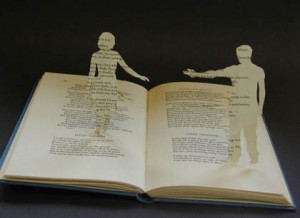During the production of the movie version of The English Patient, the novel’s author, Michael Ondaatje, became friends with the film editor for the project, Walter Murch. Their relationship eventually blossomed into The Conversations, a book of, well, conversations, Ondaatje and Murch’s back-and-forth about any subject under the sun, filmmaking, art, fiction, science, poetry. A wonderfully intelligent and witty book.
One of my favorite sections is their discussion of the quantum physicist John Wheeler’s invention of a variation on the parlor game Twenty Questions, a variation he called “Negative Twenty Questions.”
In the normal version, someone leaves briefly while the remaining folks agree to choose a particular object that’s in the room. The returning person gets twenty questions to guess the agreed-upon object, with “Is it bigger than a breadbox?” being the classic opening gambit.
In Negative Twenty Questions, however, all the remaining folks privately pick their own objects, though the person returning doesn’t know this. In fact, as Murch observes, “Nobody knows what anyone else is thinking. The game proceeds regardless, which is where the fun begins.”
When returning Joe (let’s call him) asks the standard bigger-than-a-breadbox question, if the first person says No, then the other players, who may have selected objects that are bigger, now have to look around the room for something that fits the definition. And if “Is it Hollow?” is Joe’s next question, then any of the players who chose new and unfortunately solid objects now have to search around for a new appropriate object. As Murch says, “a complex vortex of decision making is set up, a logical but unpredictable chain of ifs and thens.” Yet somehow this steady improvisation finally leads—though not always, there’s the tension—to a final answer everyone can agree with, despite the odds.
Wheeler thought this game reflected the structure of the quantum world, yet Murch observes that it reminds him of making a film: the casting will influence how the costumer will dress the lead actor, which will in turn influence the art director’s design of the set, which in turn influences. . . and somehow, with all these subtle developing variables, a movie gets made.
Reading this section in The Conversations over again recently (it’s the kind of book that invites returning to and making rediscoveries), I was reminded of the great Brazilian writer Clarice Lispector’s description of writing a novel, from her Selected Cronicas:
The book came together simultaneously as it were, emerging more here than there, or suddenly more there than here: I would interrupt a sentence in Chapter Ten, let us say, in order to write Chapter Two, which I would then abandon for months on end while I wrote Chapter Eighteen. I showed endless patience: putting up with the considerable inconvenience of disorder without any reassurance that I would finish the book.
How familiar this seems to me, various parts of a book calling to each other, unexpected connections reaching out.
I first became aware of this process when I was a graduate student at City College and studied with Donald Barthelme. I remember my mentor urging me during one conference to consider writing a novel—probably because, at the time, I mainly wrote prose poems that barely extended into the territory of the short story. Don always liked to mix things up a bit. The very idea, though, alarmed me. I couldn’t imagine ever writing any single thing that continued into hundreds of pages. So my squeaky, timid protest to Don’s suggestion was, “I wouldn’t know where to begin.”
His response surprised me. “Whenever I begin a novel,” he said, “the beginning never stays at the beginning. It ends up in the middle, or near the end. It never stays put where I started.”
I’d always assumed that one began a novel by starting on page one and slogging through to the last sentence, so this revelation served as some relief to me, and made the task of writing a novel appear a little more approachable. Still, I don’t think I fully understood him until I began, years later, to work on my first novel, and found myself putting together its different sections like pieces of a puzzle that had as yet no defined borders, while trying to discover and answer my own secret twenty questions.
